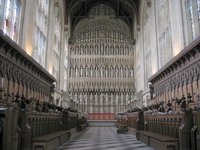New College, Oxford
|
|
| New College | |
|---|---|
| Missing image Newcollege_wall-hall-chapel_oxondude.jpg | |
| Established | 1379 |
| Sister College | King's College |
| Warden | Prof. Alan Ryan |
| Graduates | 188 |
| Undergraduates | 439 |
</div>
New College is one of the constituent colleges of the University of Oxford in the United Kingdom. Its official name, College of St Mary, is the same as that of the older Oriel College; hence, it has been referred to as the "New College of St Mary," or simply "New College." One of the wealthiest and most famous of the Oxford colleges, it stands along Holywell Street and New College Lane (known for Oxford's Bridge of Sighs), next to All Souls College and The Queen's College.
| Contents |
History
Newcollege_old_quad_oxondude.jpg
Newcollege_gate_to_gardens_oxondude.jpg
Despite its name, New College is one of the oldest of the Oxford colleges, having originally been founded in 1379. It was founded by William of Wykenham, Bishop of Winchester. The college was originally founded to educate priests for the parish of Winchester. In 1348 the Black Death claimed the lives of many priests in the parish, and William intended to replace them quickly.
As well as being the first Oxford college for undergraduates and the first to have Senior members of the college give tutorials, New College was the first college in Oxford to center on a main "quadrangle," with student rooms, a dining hall, a library, and study rooms within the square ring of buildings and gates. The porters there will tell you that the reason why the huge doors on both entrances have much smaller cut-out doors is because the college was designed and built to fortify against any outside attackers. The quadrangle design inspired many of the later colleges, perhaps most strangely St. Catherine's College, Oxford because Arne Jacobsen was an ardent admirer of "the Oval" or oval-shaped lawn in the old quad.
The College grounds are amongst the largest and most beautiful in Oxford. The Cloisters and the Chapel are of particular note, as is the old City Wall (around which the College is built). The gardens are equally impressive and include the decorative Mound (which originally had steps, but is now smooth with one set of stairs. Visitors and students enjoy standing at the bottom of the stairs facing the Mound and clapping, listening to the sharp echoes). The college is also in possession of a respectable collection of silver, and a notable "unicorn horn" (really a narwhale tusk).
Notable former students
Newcollege_chapel_oxondude.jpg
- John Astor
- Waldorf Astor
- Edward Emerson Forbes
- Kate Beckinsale (although she left to pursue her film career before graduation)
- Tony Benn
- Angus Deayton
- Hugh Gaitskell
- Victor Gollancz
- Hugh Grant
- Dennis Potter
- Tim Sebastian
- Rick Stein
- William Warham
- Peter Hobbs
Academics/teachers
BridgeOfSighsOxford20040124CopyrightKaihsuTai_.jpg
Trivia
Newcollege_oldwall_oxondude.jpg
- Amongst the many art treasures at New College, one may find El Greco's painting of St James and Jacob_Epstein's statue of Lazarus Rising from the Dead.
- During the summer of 2004, it was used as one of the main filming locations for the movie "Harry Potter and the Goblet of Fire."
- Was used in the movie "Tomorrow Never Dies" when James Bond is at Oxford studying languages. Also, what in the movie is called the "Swedish Embassy" is in reality one of the Hollywell Buildings of New College.
External link
- Official website (http://www.new.ox.ac.uk/)
|
Missing image | |
|
All Souls |
Balliol |
Brasenose |
Christ Church |
Corpus Christi |
Exeter |
Green |
Harris Manchester |
Hertford |
Jesus |
Keble |
Kellogg |
Lady Margaret Hall |
Linacre |
Lincoln |
Magdalen |
Mansfield |
Merton |
New College |
Nuffield |
Oriel |
Pembroke |
Queen's |
St Anne's |
St Antony's |
St Catherine's |
St Cross |
St Edmund Hall |
St Hilda's |
St Hugh's |
St John's |
St Peter's |
Somerville |
Templeton |
Trinity |
University |
Wadham |
Wolfson |
Worcester
| |
|
Blackfriars | Campion Hall | Greyfriars | Regent's Park College | St Benet's Hall | St Stephen's House | Wycliffe Hall | |


